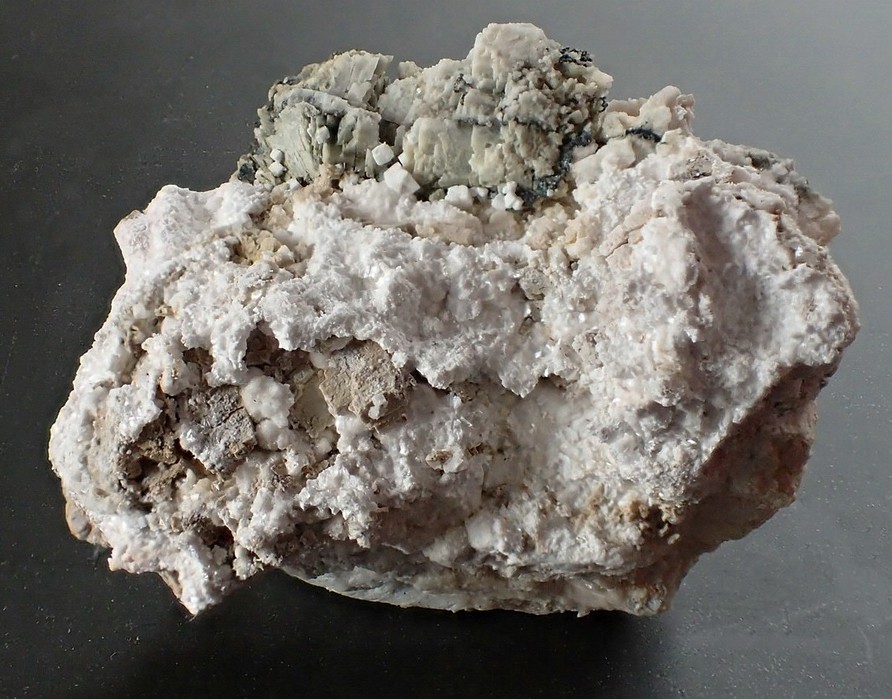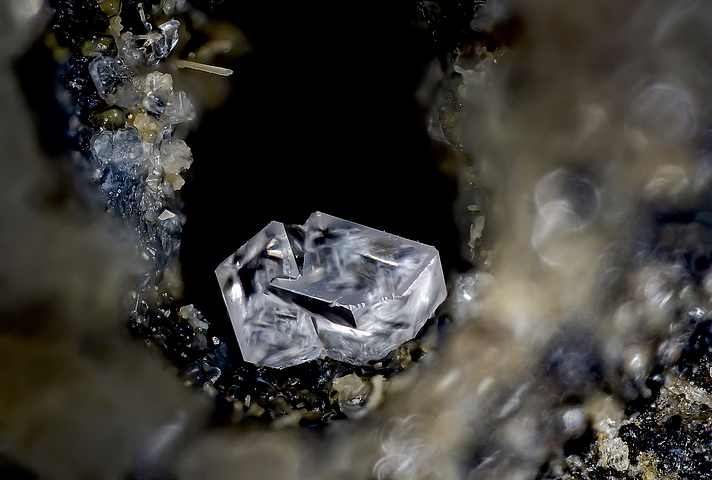Orschallite
A valid IMA mineral species
This page is currently not sponsored. Click here to sponsor this page.
About Orschallite
Formula:
Ca3(SO3)2(SO4) · 12H2O
Colour:
Colorless
Lustre:
Vitreous
Hardness:
4
Specific Gravity:
1.90
Crystal System:
Trigonal
Name:
The name is in honour of Mr. P. Orschall, Cologne, Germany, who discovered this sulfite mineral and was also the first to find the new sulfite mineral hannebachite at the same locality (Weidenthaler, Tillmanns & Hentschel, 1993).
This page provides mineralogical data about Orschallite.
Unique Identifiers
Mindat ID:
3022
Long-form identifier:
mindat:1:1:3022:5
GUID
(UUID V4):
(UUID V4):
09dea941-583a-4e23-9270-388e28c24665
IMA Classification of Orschallite
Classification of Orschallite
4.JE.15
4 : OXIDES (Hydroxides, V[5,6] vanadates, arsenites, antimonites, bismuthites, sulfites, selenites, tellurites, iodates)
J : Arsenites, antimonites, bismuthites, sulfites, selenites, tellurites; iodates
E : Sulfites
4 : OXIDES (Hydroxides, V[5,6] vanadates, arsenites, antimonites, bismuthites, sulfites, selenites, tellurites, iodates)
J : Arsenites, antimonites, bismuthites, sulfites, selenites, tellurites; iodates
E : Sulfites
34.8.7.1
34 : SELENITES, TELLURITES AND SULFITES
8 : Compound Selenites, Tellurites and Sulfites
34 : SELENITES, TELLURITES AND SULFITES
8 : Compound Selenites, Tellurites and Sulfites
Mineral Symbols
As of 2021 there are now IMA–CNMNC approved mineral symbols (abbreviations) for each mineral species, useful for tables and diagrams.
| Symbol | Source | Reference |
|---|---|---|
| Ors | IMA–CNMNC | Warr, L.N. (2021). IMA–CNMNC approved mineral symbols. Mineralogical Magazine, 85(3), 291-320. doi:10.1180/mgm.2021.43 |
Physical Properties of Orschallite
Vitreous
Transparency:
Transparent
Colour:
Colorless
Streak:
White
Hardness:
4 on Mohs scale
Density:
1.90(3) g/cm3 (Measured) 1.87 g/cm3 (Calculated)
Optical Data of Orschallite
Type:
Uniaxial (+)
RI values:
nω = 1.494(4) nε = 1.496(4)
Max Birefringence:
δ = 0.002

Image shows birefringence interference colour range (at 30µm thickness)
and does not take into account mineral colouration.
and does not take into account mineral colouration.
Surface Relief:
Moderate
Chemistry of Orschallite
Mindat Formula:
Ca3(SO3)2(SO4) · 12H2O
Elements listed:
Crystallography of Orschallite
Crystal System:
Trigonal
Class (H-M):
3m (3 2/m) - Hexagonal Scalenohedral
Space Group:
R3c
Setting:
R3c
Cell Parameters:
a = 11.35 Å, c = 28.32 Å
Ratio:
a:c = 1 : 2.495
Unit Cell V:
3,159.48 ų (Calculated from Unit Cell)
Z:
6
Morphology:
Pseudo-cubic crystals.
Crystal Structure
Load
Unit Cell | Unit Cell Packed
2x2x2 | 3x3x3 | 4x4x4
Unit Cell | Unit Cell Packed
2x2x2 | 3x3x3 | 4x4x4
Show
Big Balls | Small Balls | Just Balls | Spacefill
Polyhedra Off | Si Polyhedra | All Polyhedra
Remove metal-metal sticks
Big Balls | Small Balls | Just Balls | Spacefill
Polyhedra Off | Si Polyhedra | All Polyhedra
Remove metal-metal sticks
Display Options
Black Background | White Background
Perspective On | Perspective Off
2D | Stereo | Red-Blue | Red-Cyan
Black Background | White Background
Perspective On | Perspective Off
2D | Stereo | Red-Blue | Red-Cyan
View
CIF File Best | x | y | z | a | b | c
CIF File Best | x | y | z | a | b | c
Rotation
Stop | Start
Stop | Start
Labels
Console Off | On | Grey | Yellow
Console Off | On | Grey | Yellow
Data courtesy of the American Mineralogist Crystal Structure Database. Click on an AMCSD ID to view structure
| ID | Species | Reference | Link | Year | Locality | Pressure (GPa) | Temp (K) |
|---|---|---|---|---|---|---|---|
| 0014633 | Orschallite | Weidenthaler C, Tillmanns E, Hentschel G (1993) Orschallite, Ca3(SO3)2SO4*12H2O, a new calcium-sulfite-sulfate-hydrate mineral Mineralogy and Petrology 48 167-177 | 1993 | Hannebacher Ley, Hannebach, Eifel, Germany | 0 | 293 |
CIF Raw Data - click here to close
X-Ray Powder Diffraction
Powder Diffraction Data:
| d-spacing | Intensity |
|---|---|
| 8.11 Å | (80) |
| 5.73 Å | (100) |
| 3.63 Å | (60) |
| 3.28 Å | (40) |
| 2.69 Å | (80) |
| 2.11 Å | (40) |
Comments:
Hannebacher Ley, Rhineland-Palatinate, Germany. The data are from the type description.
Geological Environment
Paragenetic Mode(s):
| Paragenetic Mode | Earliest Age (Ga) |
|---|---|
| Stage 7: Great Oxidation Event | <2.4 |
| 45a : [Sulfates, arsenates, selenates, antimonates] | |
| 47b : [Sulfates and sulfites] | |
| Stage 10b: Anthropogenic minerals | <10 Ka |
| 56 : Slag and smelter minerals (see also #51 and #55) |
Type Occurrence of Orschallite
General Appearance of Type Material:
Colorless, transparent pseudo-cubic crystals to 0.3 mm.
Place of Conservation of Type Material:
University of Vienna, Austria.
Geological Setting of Type Material:
Submarine pillow basalts.
Associated Minerals at Type Locality:
Synonyms of Orschallite
Other Language Names for Orschallite
Common Associates
Associated Minerals Based on Photo Data:
Related Minerals - Strunz-mindat Grouping
| 4.JE.X | Albertiniite | Fe2+(SO3) · 3H2O |
| 4.JE. | Mikenewite | Mn2+(S4+O3) · 3H2O |
| 4.JE. | Vanpeltite | (Mo2O5)(S4+O3) · 4H2O |
| 4.JE.05 | Gravegliaite | Mn2+SO3 · 3H2O |
| 4.JE.05 | Fleisstalite | FeSO3 · 3H2O |
| 4.JE.10 | Hannebachite | CaSO3 · H2O |
| 4.JE.20 | Scotlandite | PbSO3 |
| 4.JE.25 | Kollerite | (NH4)2Fe3+(SO3)2(OH) · H2O |
Other Information
IR Spectrum:
The infrared pattern has absorption bands for H2O (3300 and 1630 cm-1), for SO3 (945 and 630-650 cm-1), and for SO4 (1100 cm-1).
Thermal Behaviour:
TGA of synthetic material showed endothermic dehydration at 120°C to anhydrite with a weight loss of 34.5%.
Notes:
Rapidly volatilizes under an electron microprobe beam.
Health Risks:
No information on health risks for this material has been entered into the database. You should always treat mineral specimens with care.
Internet Links for Orschallite
mindat.org URL:
https://www.mindat.org/min-3022.html
Please feel free to link to this page.
Please feel free to link to this page.
Search Engines:
External Links:
Mineral Dealers:
References for Orschallite
Localities for Orschallite
Locality List
 - This locality has map coordinates listed.
- This locality has map coordinates listed.
 - This locality has estimated coordinates.
ⓘ - Click for references and further information on this occurrence.
? - Indicates mineral may be doubtful at this locality.
- This locality has estimated coordinates.
ⓘ - Click for references and further information on this occurrence.
? - Indicates mineral may be doubtful at this locality.
 - Good crystals or important locality for species.
- Good crystals or important locality for species.
 - World class for species or very significant.
(TL) - Type Locality for a valid mineral species.
(FRL) - First Recorded Locality for everything else (eg varieties).
- World class for species or very significant.
(TL) - Type Locality for a valid mineral species.
(FRL) - First Recorded Locality for everything else (eg varieties).
All localities listed without proper references should be considered as questionable.
Canada | |
| Reiner Mielke 2015 |
| Reiner Mielke 2016 | |
France | |
| Eytier J.R. & Ch. et al. (2004) |
Germany (TL) | |
| Weidenthaler et al. (1993) +1 other reference |
USA | |
| Kasatkin et al. (2014) +1 other reference |
Quick NavTopAbout OrschalliteUnique IdentifiersIMA Classification Classification Mineral SymbolsPhysical Properties Optical Data Chemistry Crystallography Crystal StructureX-Ray Powder DiffractionGeological EnvironmentType Occurrence SynonymsOther LanguagesCommon AssociatesStrunz-MindatOther InformationInternet Links References Localities Locality List






 symbol to view information about a locality.
The
symbol to view information about a locality.
The 




Shaft #8, Nipissing 404, Coleman Township, Cobalt area, Cobalt-Gowganda region, Timiskaming District, Ontario, Canada